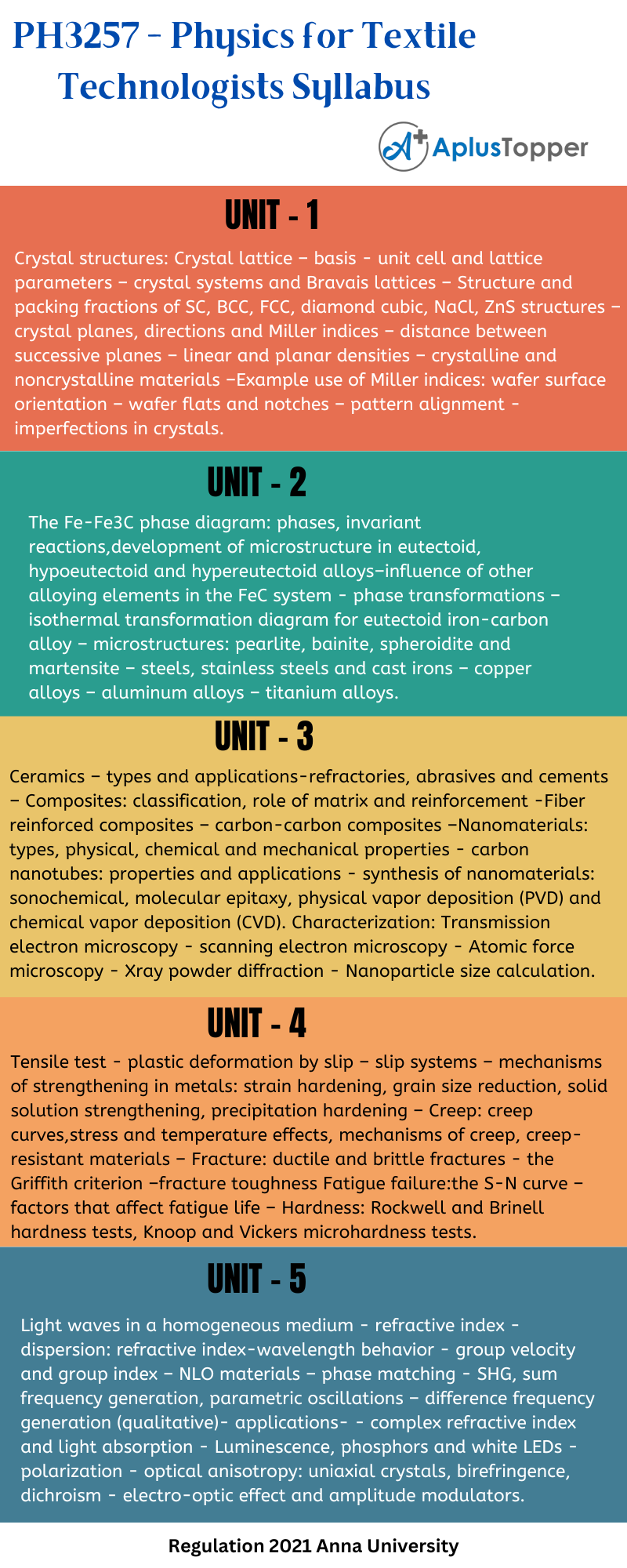Anna University Textile Chemistry syllabus of B. Tech. Textile Chemistry Semester II. In this article, we are glad to provide the syllabus of the Physics for Textile Technologists.
We aim to provide the following semester II PH3257 – Physics for Textile Technologists syllabus in a detailed manner. We include the appropriate syllabus textbooks and references. Hope this information is useful. Don’t forget to share with your classmates.
If you want to know more about the B. Tech. Textile Chemistry Syllabus is connected to an affiliated institution’s four-year undergraduate degree program. We provide you with a detailed Year-wise, semester-wise, and Subject-wise syllabus in the following link B. Tech. Textile Chemistry Syllabus Regulation 2021 Anna University.
Aim Of Objectives:
- To make the students effectively to understand the basics of crystallography and crystal imperfections.
- To enable the students to get knowledge on ferrous and nonferrous alloys.
- To impart knowledge on the basics of ceramics, composites and nanomaterials.
- To learn about mechanical properties of materials.
- To introduce the concept of light – matter interactions and electro-optical effects.
PH3257 – Physics for Textile Technologists Syllabus
Unit – I: Crystallography
Crystal structures: Crystal lattice – basis – unit cell and lattice parameters – crystal systems and Bravais lattices – Structure and packing fractions of SC, BCC, FCC, diamond cubic, NaCl, ZnS structures – crystal planes, directions and Miller indices – distance between successive planes – linear and planar densities – crystalline and noncrystalline materials –Example use of Miller indices: wafer surface orientation – wafer flats and notches – pattern alignment – imperfections in crystals.
Unit – II: Ferrous And Nonferrous Alloys
The Fe-Fe3C phase diagram: phases, invariant reactions,development of microstructure in eutectoid, hypoeutectoid and hypereutectoid alloys–influence of other alloying elements in the FeC system – phase transformations –isothermal transformation diagram for eutectoid iron-carbon alloy – microstructures: pearlite, bainite, spheroidite and martensite – steels, stainless steels and cast irons – copper alloys – aluminum alloys – titanium alloys.
Unit – III: Ceramics, Composites And Nano Materials
Ceramics – types and applications-refractories, abrasives and cements – Composites: classification, role of matrix and reinforcement -Fiber reinforced composites – carbon-carbon composites –Nanomaterials: types, physical, chemical and mechanical properties – carbon nanotubes: properties and applications – synthesis of nanomaterials: sonochemical, molecular epitaxy, physical vapor deposition (PVD) and chemical vapor deposition (CVD). Characterization: Transmission electron microscopy – scanning electron microscopy – Atomic force microscopy – Xray powder diffraction – Nanoparticle size calculation.

Unit – IV: Mechanical Properties
Tensile test – plastic deformation by slip – slip systems – mechanisms of strengthening in metals: strain hardening, grain size reduction, solid solution strengthening, precipitation hardening – Creep: creep curves,stress and temperature effects, mechanisms of creep, creep-resistant materials – Fracture: ductile and brittle fractures – the Griffith criterion –fracture toughness Fatigue failure:the S-N curve – factors that affect fatigue life – Hardness: Rockwell and Brinell hardness tests, Knoop and Vickers microhardness tests.
Unit – V: Optical Properties Of Materials
Light waves in a homogeneous medium – refractive index – dispersion: refractive index-wavelength behavior – group velocity and group index – NLO materials – phase matching – SHG, sum frequency generation, parametric oscillations – difference frequency generation (qualitative)- applications- – complex refractive index and light absorption – Luminescence, phosphors and white LEDs – polarization – optical anisotropy: uniaxial crystals, birefringence, dichroism – electro-optic effect and amplitude modulators.
Text Books:
- R. Balasubramaniam, Callister’s Materials Science and Engineering.Wiley (Indian Edition), 2014.
- V.Raghavan. Materials Science and Engineering: A First Course, Prentice Hall India Learning Private Limited, 2015.
- Safa O. Kasap, Optoelectronics and Photonics, Dorling Kindersley India, 2009
REFERENCES:
- J.F.Shackelford. Introduction to Materials Science for Engineers. Pearson, 2015.
- Wendelin Wright and Donald Askeland, Essentials of Materials Science and Engineering, CL Engineering, 2013.
- William Smith and Javad Hashemi, Foundations of Materials Science and Engineering, McGraw-Hill Education, 2018.
- Rajesh Mishra and Jiri Militky, Nanotechnology in Textiles: Theory and Application, Elsevier, 2018.
- Mark Fox, Optical Properties of Solids, Oxford Univ. Press, 2012.
Related Posts On Semester – II:
Also Check:
